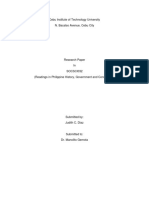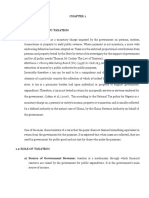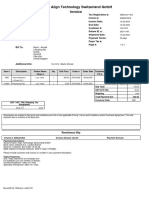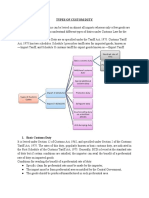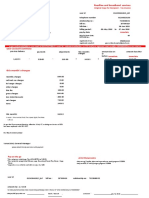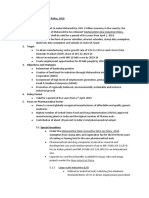0 ratings0% found this document useful (0 votes)
6 viewsTAXATION
TAXATION
Uploaded by
DELA TORRE, SHENANORCopyright:
© All Rights Reserved
Available Formats
Download as DOCX, PDF, TXT or read online from Scribd
TAXATION
TAXATION
Uploaded by
DELA TORRE, SHENANOR0 ratings0% found this document useful (0 votes)
6 views3 pagesCopyright
© © All Rights Reserved
Available Formats
DOCX, PDF, TXT or read online from Scribd
Share this document
Did you find this document useful?
Is this content inappropriate?
Copyright:
© All Rights Reserved
Available Formats
Download as DOCX, PDF, TXT or read online from Scribd
Download as docx, pdf, or txt
0 ratings0% found this document useful (0 votes)
6 views3 pagesTAXATION
TAXATION
Uploaded by
DELA TORRE, SHENANORCopyright:
© All Rights Reserved
Available Formats
Download as DOCX, PDF, TXT or read online from Scribd
Download as docx, pdf, or txt
You are on page 1of 3
Name: PAHUGOT, SHENA NORREN Section: BSIT-3D
Date: APRIL 24, 2024
1. Define the power of taxation and elucidate its significance in the context
of governance and fiscal policy. Provide examples to support your
explanation.
The power of taxation in the context of government: is the authority of
a sovereign state to collect money or property from individuals or businesses
within its borders, following fair rules of distribution. Taxes are crucial for
building the Philippines. They act as the backbone of the government's
finances, funding its operations and expenses. Governments use the money
collected from citizens to pay for welfare programs, the military, roads and
bridges, government employees, science programs, public schools, and the
many other services a government is responsible for.
The power of taxation in the context of fiscal policy: Taxes are not only
a source of state finance used for public investment, but the tax function can
also be used to control state policy which is more commonly known as the
budgeter function and the regular function. Taxation is considered as a tool
of fiscal policy. For instance, taxes fund public services like schools and
hospitals, ensuring everyone have access to essential resources.
2. Enumerate and explain the primary purposes of taxation.
Taxation has three main purposes:
To manage resources efficiently: taxation serves the purpose of resource
allocation by ensuring that resources are allocated efficiently within the
economy.
To reduce income inequality: taxation is utilized for income redistribution,
aiming to reduce inequalities in the distribution of income and wealth.
To stabilize the economy: taxation contributes to economic stability by
playing a role in macroeconomic management.
a. How do these purposes align with the objectives of government and
societal needs? Provide real-world instances to illustrate your points.
These goals align with what governments and societies need by
ensuring fair distribution of wealth, promoting economic growth, and
maintaining stability. For example, taxes can discourage harmful activities
like pollution, help redistribute wealth from the rich to the poor, and
stimulate spending during economic downturns. However, sometimes these
goals can conflict. For instance, policies that redistribute income may affect
resource allocation. Therefore, governments must balance these objectives
carefully to create effective tax policies that benefit everyone.
3. What is the definition of a tax according to economic and legal
perspectives?
Economic: Taxes are mandatory contributions levied on individuals or
corporations by a government entity—whether local, regional, or national.
Legal Perspectives: Taxation is a term for when a taxing authority, usually
a government, levies or imposes a financial obligation on its citizens or
residents.
a. Discuss the key elements that constitute a tax and differentiate it from
other forms of revenue generation for the government.
Taxes are money collected by the government from people and
businesses, and they're mandatory — you have to pay them. Unlike other
ways the government makes money, like fees for services or selling stuff,
taxes aren't tied to anything specific you get in return. When you pay taxes,
you don't get a direct benefit for the exact amount you paid. However, there
are some exceptions. For example, payroll taxes taken from your paycheck
might go toward things like retirement or medical benefits. And taxes on
things like gasoline might help pay for roads. But in general, taxes are
compulsory payments that don't come with a guaranteed return.
4. Outline the different classifications of taxes based on various criteria
such as nature, scope, and impact.
Direct Taxes:
Nature: Levied directly on individuals or organizations.
Scope: Wide-ranging, covering various sources of income, assets, and
profits.
Impact: Directly felt by taxpayers, influencing their income, savings, and
investment decisions.
Indirect Taxes:
Nature: Imposed on goods and services, collected by intermediaries from
consumers.
Scope: Limited, primarily applied to specific goods and services.
Impact: Indirectly felt by consumers, affecting consumption patterns and
market dynamics.
a. Provide examples for each classification and discuss their implications
on individuals, businesses, and the economy at large.
Direct taxes, such as income tax and corporate tax, are paid by
individuals and businesses directly to the government. For individuals, these
taxes mean less money to spend and save, while businesses have fewer
profits for growth.
Indirect taxes, like sales tax and value-added tax (VAT), are added
to the prices of goods and services, making things more expensive for
consumers and more complex for businesses. Both types of taxes are vital
for government income and economic stability, affecting how people spend,
how businesses grow, and how the economy performs overall.
5. Critically analyze the role of taxation in addressing income inequality
and promoting social welfare.
Taxation helps make things fairer by making sure everyone contributes
according to their means. When higher earners pay more taxes, it helps
spread wealth around. Also, giving tax breaks to people with lower incomes
helps them manage their money better. Taxes on big inheritances stop rich
families from getting richer and ensure everyone gets a fair shot. But some
people try to avoid paying taxes, which isn't fair.
Overall, taxes pay for important things like healthcare and education,
which help everyone live better lives. They also help fix big problems like
poverty and inequality by giving everyone a fair chance. But we need to
make sure tax rules are fair and followed properly to make the system work
for everyone.
a. How do progressive, regressive, and proportional tax systems contribute
to or mitigate socioeconomic disparities?
Progressive taxes make wealthier individuals contribute a larger portion of
their income, which helps fund programs supporting those with fewer
resources. They are like a balancing act, ensuring that those who can afford
it most contribute more to society.
On the other hand, regressive taxes take a bigger slice from the incomes of
lower earners, widening the wealth gap. This can create more financial strain
for those who are already struggling.
Proportional taxes treat everyone equally, but they don't necessarily
change the gap between rich and poor. While they might seem fair, they may
not provide enough support to those who need it most. In essence, the type
of tax system in place can either help narrow or widen the gap between the
wealthy and the less fortunate, impacting socioeconomic disparities in
society.
You might also like
- Importance and Role of TaxationDocument7 pagesImportance and Role of TaxationZale Crud100% (2)
- E-Ticket Receipt: Mrs Uzma ShababDocument1 pageE-Ticket Receipt: Mrs Uzma Shababسلی سلای100% (1)
- RESEARCHDocument5 pagesRESEARCHmanuelitofuentescruzNoch keine Bewertungen
- Taxation ExamDocument1 pageTaxation Exammails2ssmmNoch keine Bewertungen
- 5.1 Taxes: Definition, Principles, Objectives and ClassificationsDocument12 pages5.1 Taxes: Definition, Principles, Objectives and Classificationsdr7dh8c2sdNoch keine Bewertungen
- PUBLIC FISCAL ADMINISTRATION - docxSUMDocument20 pagesPUBLIC FISCAL ADMINISTRATION - docxSUMRenalyn FortezaNoch keine Bewertungen
- The Importance of Taxes: What Is A "Tax"Document6 pagesThe Importance of Taxes: What Is A "Tax"Hami KhaNNoch keine Bewertungen
- Importance of Tax in EconomyDocument7 pagesImportance of Tax in EconomyAbdul WahabNoch keine Bewertungen
- Unit 2Document21 pagesUnit 2ayyoogroNoch keine Bewertungen
- Taxation FinalDocument10 pagesTaxation FinalMaelyn GelilangNoch keine Bewertungen
- BACC3 - Antiniolos, FaieDocument21 pagesBACC3 - Antiniolos, Faiemochi antiniolosNoch keine Bewertungen
- Assignment O2 TaxDocument10 pagesAssignment O2 Taxayushiisingh2002Noch keine Bewertungen
- Government RevenueDocument6 pagesGovernment Revenuenihadarfin19Noch keine Bewertungen
- MGMT 3051 - TAXATION 1 Economic Principles - Additional ResourcesDocument57 pagesMGMT 3051 - TAXATION 1 Economic Principles - Additional ResourcesaplacetokeepmynotesNoch keine Bewertungen
- Social ScienceDocument5 pagesSocial Sciencejudith DiazNoch keine Bewertungen
- Ans Taxation 1Document23 pagesAns Taxation 1Priscilla AdebolaNoch keine Bewertungen
- Educ 612 Reaction Paper Unit 3Document2 pagesEduc 612 Reaction Paper Unit 3Cristobal RabuyaNoch keine Bewertungen
- Taxation Important Questions SemDocument72 pagesTaxation Important Questions SemPooja GadiyaNoch keine Bewertungen
- Applied Econ - TaxationDocument5 pagesApplied Econ - Taxationsweet miloNoch keine Bewertungen
- Part I Introduction To TaxationDocument56 pagesPart I Introduction To TaxationabrehamdNoch keine Bewertungen
- Taxation 123Document3 pagesTaxation 123Cantos FlorenceNoch keine Bewertungen
- Taxation Is The ProcessDocument7 pagesTaxation Is The ProcessJaneil FrancisNoch keine Bewertungen
- Buque - Prelim Exam-Income TaxationDocument3 pagesBuque - Prelim Exam-Income TaxationVillanueva, Jane G.Noch keine Bewertungen
- Sin TaxDocument1 pageSin TaxVj Lentejas IIINoch keine Bewertungen
- 3424324Document3 pages3424324achijohuxNoch keine Bewertungen
- Chapter 2 TaxationDocument19 pagesChapter 2 Taxationabdiabera092680Noch keine Bewertungen
- OriginalDocument95 pagesOriginalRajesh AbhiNoch keine Bewertungen
- Unit 2-Allocation, Distribution and StabilisationDocument63 pagesUnit 2-Allocation, Distribution and Stabilisationironman73500Noch keine Bewertungen
- Tax Law 0.4Document21 pagesTax Law 0.4Tommy AdemolaNoch keine Bewertungen
- Lec 10 ImaDocument13 pagesLec 10 ImaSean Muriithi PaulNoch keine Bewertungen
- Related: BBA From Amity University, Ranchi (Graduated 2022)Document4 pagesRelated: BBA From Amity University, Ranchi (Graduated 2022)Shy DyNoch keine Bewertungen
- What Is The Role of Government?Document3 pagesWhat Is The Role of Government?Archana SeeburrunNoch keine Bewertungen
- Lecture One - Introduction To TaxationDocument49 pagesLecture One - Introduction To TaxationIbsa AbrahimNoch keine Bewertungen
- The Problem With Our Tax System and How It Affects UsDocument65 pagesThe Problem With Our Tax System and How It Affects Ussan pedro jailNoch keine Bewertungen
- Chapter 12Document13 pagesChapter 12Aaron GayongaNoch keine Bewertungen
- Lorena Kukovičić - TAXATIONDocument17 pagesLorena Kukovičić - TAXATIONlorenaNoch keine Bewertungen
- Intoduction To Public Finance and Taxation TheoryDocument21 pagesIntoduction To Public Finance and Taxation TheoryAnonymous EPSHB9tXZNoch keine Bewertungen
- Intoduction To Public Finance and Taxation TheoryDocument7 pagesIntoduction To Public Finance and Taxation TheoryJeremiah Muchiri IbaraNoch keine Bewertungen
- Public Financ and TaxationDocument98 pagesPublic Financ and TaxationEyuel SintayehuNoch keine Bewertungen
- Public Revenue 17396Document54 pagesPublic Revenue 17396sneha9988gargNoch keine Bewertungen
- Legal Entity State: Government ActivityDocument3 pagesLegal Entity State: Government ActivityEunice Bucao BuesaNoch keine Bewertungen
- Introduction To TaxationDocument28 pagesIntroduction To TaxationpcandohNoch keine Bewertungen
- Taxes Are Obsolete by Beardsley Ruml, Former FED ChairmanDocument5 pagesTaxes Are Obsolete by Beardsley Ruml, Former FED ChairmanPatrick O'SheaNoch keine Bewertungen
- Copy Ucu Revenue Law Notes LLB 4Document24 pagesCopy Ucu Revenue Law Notes LLB 4pauls graceNoch keine Bewertungen
- Relevance of Taxation1Document10 pagesRelevance of Taxation1einol padalNoch keine Bewertungen
- Roll No: 20134026 Name: Jegatheesh P Topic: Taxation What Is Taxation?Document6 pagesRoll No: 20134026 Name: Jegatheesh P Topic: Taxation What Is Taxation?Jegatheesh PNoch keine Bewertungen
- Direct TaxDocument98 pagesDirect Taxmonali raiNoch keine Bewertungen
- Tax Complience: Introduction and BackgroundDocument13 pagesTax Complience: Introduction and Backgroundally jumanneNoch keine Bewertungen
- VI Sem TaxationDocument107 pagesVI Sem Taxationsakshimedia389Noch keine Bewertungen
- Enumerate The Inherent Powers of The State and Explain Each PowersDocument2 pagesEnumerate The Inherent Powers of The State and Explain Each PowersMary Ingrid Arellano RabulanNoch keine Bewertungen
- Taxation 1 MOA HOMEOWNERSDocument22 pagesTaxation 1 MOA HOMEOWNERSRaymundo CanindoNoch keine Bewertungen
- Taxation and Fiscal PoliciesDocument279 pagesTaxation and Fiscal PoliciesFun DietNoch keine Bewertungen
- A) Taxable CapacityDocument6 pagesA) Taxable CapacityRaytone Tonnie MainaNoch keine Bewertungen
- Purposes and EffectsDocument16 pagesPurposes and EffectsChelle OcampoNoch keine Bewertungen
- Econ SG Chap16Document16 pagesEcon SG Chap16Mohamed MadyNoch keine Bewertungen
- Fiscal Policy 2019Document23 pagesFiscal Policy 2019DNLNoch keine Bewertungen
- Chapter I Tax LawDocument44 pagesChapter I Tax LawzinedinaleNoch keine Bewertungen
- Taxes in The United StatesDocument36 pagesTaxes in The United StatesYermekNoch keine Bewertungen
- What Is Equity in EconomicsDocument4 pagesWhat Is Equity in EconomicsMuzna AijazNoch keine Bewertungen
- The Ultimate Tax Guide: Personal finance, #1From EverandThe Ultimate Tax Guide: Personal finance, #1Noch keine Bewertungen
- VCM Group Format # FINC-008-02 Prepared On: 01/04/2019 SOP Name/ Title: Expense Reimbursement FormDocument3 pagesVCM Group Format # FINC-008-02 Prepared On: 01/04/2019 SOP Name/ Title: Expense Reimbursement Formг๏ђเt кย๓คг ๒คﻮђєlNoch keine Bewertungen
- Postpaid Bill 9663070003 BM2329I016445740Document4 pagesPostpaid Bill 9663070003 BM2329I016445740Rajasekar VenkatesanNoch keine Bewertungen
- Final Details For Order #111-4892021-7769015: Shipped On November 29, 2013Document1 pageFinal Details For Order #111-4892021-7769015: Shipped On November 29, 2013alfredop71Noch keine Bewertungen
- Jazz May 21Document2 pagesJazz May 21sajuNoch keine Bewertungen
- Thursday Warsaw (Warszawa) Dworzec Zachodni: Bus Connection 1261Document5 pagesThursday Warsaw (Warszawa) Dworzec Zachodni: Bus Connection 1261Octavian AnghelNoch keine Bewertungen
- 1-5 Chapter CDDocument109 pages1-5 Chapter CDSandeep nayakaNoch keine Bewertungen
- Dictionary of Trade Policy Terms 6th Edition Walter Goode 2024 Scribd DownloadDocument49 pagesDictionary of Trade Policy Terms 6th Edition Walter Goode 2024 Scribd Downloadkarpenruiman49100% (2)
- Due Date Telephone Number Amount Payable: Summary of Charges Usage History (6 Months)Document3 pagesDue Date Telephone Number Amount Payable: Summary of Charges Usage History (6 Months)krishna GNoch keine Bewertungen
- IDT 2 New Question PaperDocument11 pagesIDT 2 New Question Paperneha manglaniNoch keine Bewertungen
- Align Technology Switzerland GMBH InvoiceDocument1 pageAlign Technology Switzerland GMBH InvoicehamadachampNoch keine Bewertungen
- September 1-3613311284991 - BM2333I006304001Document9 pagesSeptember 1-3613311284991 - BM2333I006304001Jihoon BongNoch keine Bewertungen
- Types of Custom DutyDocument3 pagesTypes of Custom DutyKarina ManafNoch keine Bewertungen
- Airtel Postpaid BillDocument5 pagesAirtel Postpaid BillAbhishek GuptaNoch keine Bewertungen
- Perpres 112 2022 Renewable Energy Acceleration (Presentation)Document10 pagesPerpres 112 2022 Renewable Energy Acceleration (Presentation)maharNoch keine Bewertungen
- Elephant Design Proforma InvoiceDocument1 pageElephant Design Proforma InvoiceRamdas NagareNoch keine Bewertungen
- NV Energy Residential RatesDocument2 pagesNV Energy Residential Ratesklik95Noch keine Bewertungen
- Development Planning - Development Plan: Is A Mid-Term Government Plan That Maps Out What Government Wants To Achieve in 5 YearsDocument27 pagesDevelopment Planning - Development Plan: Is A Mid-Term Government Plan That Maps Out What Government Wants To Achieve in 5 YearsenoskNoch keine Bewertungen
- Indirect TaxesDocument76 pagesIndirect TaxesMit ThakerNoch keine Bewertungen
- SOA009005567079Document2 pagesSOA009005567079Jeevan NJNoch keine Bewertungen
- Chapter 3 - International TradeDocument11 pagesChapter 3 - International TradeArmie LandritoNoch keine Bewertungen
- Maharashtra New Industrial Policy On Pharmaceutical SectorDocument3 pagesMaharashtra New Industrial Policy On Pharmaceutical SectorDivya AnandNoch keine Bewertungen
- Aggregate Costing For MatarbariDocument1 pageAggregate Costing For Matarbarihabib rahman100% (1)
- Maths Lit p1 Gr11 QP Nov2020 Eng DDocument9 pagesMaths Lit p1 Gr11 QP Nov2020 Eng Dreconcilemalele3Noch keine Bewertungen
- Tender NO.13-Supply, Installation, - Commissioning and Testing of Diesel Generator 100 KW-Financial BidDocument6 pagesTender NO.13-Supply, Installation, - Commissioning and Testing of Diesel Generator 100 KW-Financial BidAbdul MoezNoch keine Bewertungen
- Nigerian Gas Transmission Tariff Framework StudyDocument19 pagesNigerian Gas Transmission Tariff Framework StudyDaniel DamboNoch keine Bewertungen
- Tariff Calculating Model For Natural Gas Transport PDFDocument7 pagesTariff Calculating Model For Natural Gas Transport PDFUJJWALNoch keine Bewertungen
- INV03322103Document2 pagesINV03322103Income AuditorNoch keine Bewertungen
- Task 8Document23 pagesTask 8Anooja SajeevNoch keine Bewertungen
- Tax Reform of 2019 in UzbekistanDocument6 pagesTax Reform of 2019 in UzbekistanresearchparksNoch keine Bewertungen














